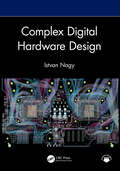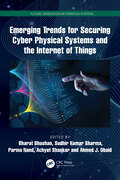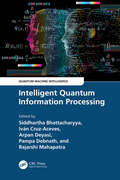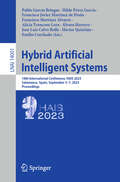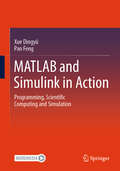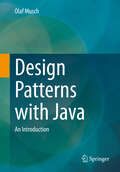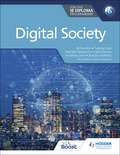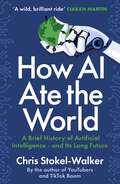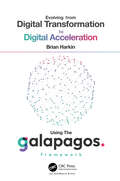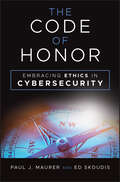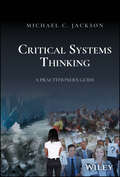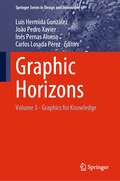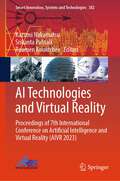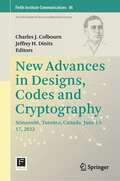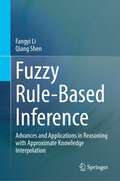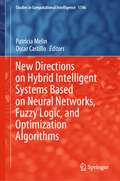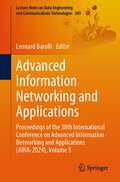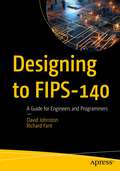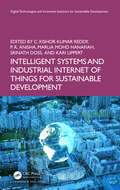- Table View
- List View
Complex Digital Hardware Design
by Istvan NagyThis book is about how to design the most complex types of digital circuit boards used inside servers, routers and other equipment, from high-level system architecture down to the low-level signal integrity concepts. It explains common structures and subsystems that can be expanded into new designs in different markets.The book is targeted at all levels of hardware engineers. There are shorter, lower-level introductions to every topic, while the book also takes the reader all they way to the most complex and most advanced topics of digital circuit design, layout design, analysis, and hardware architecture.
Complex Digital Hardware Design
by Istvan NagyThis book is about how to design the most complex types of digital circuit boards used inside servers, routers and other equipment, from high-level system architecture down to the low-level signal integrity concepts. It explains common structures and subsystems that can be expanded into new designs in different markets.The book is targeted at all levels of hardware engineers. There are shorter, lower-level introductions to every topic, while the book also takes the reader all they way to the most complex and most advanced topics of digital circuit design, layout design, analysis, and hardware architecture.
Emerging Trends for Securing Cyber Physical Systems and the Internet of Things (Future Generation Information Systems)
In the past decades, cyber-physical systems (CPSs) have been widely applied to fields such as smart grids, environment monitoring, aerospace, smart transportation, and industrial automation. Great strides have been made in CPSs to improve the computing mechanism, communication, and quality of service by applying optimization algorithms. Currently, these efforts are integrated with the applications of machine learning (ML) and artificial intelligence (AI). To maintain system reliability and stability, CPSs such as smart grids face numerous challenges, including large-scale Internet-of-Things (IoT) device adaptation, ever-increasing demands of electrical energy, and the rise of a wide range of security threats. These challenges bring forth the need to find sustainable and advanced solutions to guarantee reliable and secure operations in these systems.The goal of this book is to foster transformative, multidisciplinary, and novel approaches that ensure CPS security by taking into consideration the unique security challenges present in the environment. This book attracts contributions in all aspects pertaining to this multidisciplinary paradigm, which includes the development and implementation of Smart CPS, Supervisory Control and Data Acquisition (SCADA) systems, CPS for Industry 4.0, CPS architecture for IoT applications, and CPS forensics.This book: Discusses concepts including wireless sensor networks (WSNs), CPSs, and the IoT in a comprehensive manner. Covers routing protocols in sensor networks, attacks, and vulnerabilities in WSNs, the Internet of Cyber-Physical Things, and CPSs for industrial applications. Highlights technological advances, practical solutions, emerging trends, and prototypes related to privacy in CPSs and the IoT. Presents a pathway and architecture for proactive security schemes in CPSs to counter vulnerabilities, including phishing attacks, malware injection, internal stealing of data, and hacking. Discusses the most recent research and development on the enabling technologies for IoT-based CPSs. Owing to the scope and diversity of topics covered, the book will be of interest not only to researchers and theorists but also to professionals, material developers, technology specialists, and methodologists dealing with the multifarious aspects of data privacy and security enhancement in CPSs. The book will provide these professionals an overview of CPS security and privacy design, as well as enlighten them to promising solutions to research problems such as cyberattacks in CPS, risk identification and management in CPS, ML-based trust computational models for CPSs, nature-inspired algorithms for CPSs, and distributed consensus algorithms for event detection in CPSs. The secondary target audience of this book includes legal practitioners, hackers, cyber law policymakers, cyber forensic analysts, and global security consortiums who may use it to further their research exposure to pertinent topics in cybersecurity.
Intelligent Quantum Information Processing (Quantum Machine Intelligence)
The book discusses the foundations of intelligent quantum information processing applied to several real-life engineering problems, including intelligent quantum systems, intelligent quantum communication, intelligent process optimization, and intelligent quantum distributed networks.This book:• Showcases a detailed overview of different quantum machine learning algorithmic frameworks.• Presents real-life case studies and applications.• Provides an in-depth analysis of quantum mechanical principles.• Provides a step-by-step guide in the build-up of quantum inspired/quantum intelligent information processing systems.• Provides a video demonstration on each chapter for better understanding.It will serve as an ideal reference text for graduate students and academic researchers in fields such as electrical engineering, electronics and communication engineering, computer engineering, and information technology.
Intelligent Quantum Information Processing (Quantum Machine Intelligence)
by Siddhartha Bhattacharyya Iván Cruz-Aceves Arpan Deyasi Pampa Debnath Rajarshi MahapatraThe book discusses the foundations of intelligent quantum information processing applied to several real-life engineering problems, including intelligent quantum systems, intelligent quantum communication, intelligent process optimization, and intelligent quantum distributed networks.This book:• Showcases a detailed overview of different quantum machine learning algorithmic frameworks.• Presents real-life case studies and applications.• Provides an in-depth analysis of quantum mechanical principles.• Provides a step-by-step guide in the build-up of quantum inspired/quantum intelligent information processing systems.• Provides a video demonstration on each chapter for better understanding.It will serve as an ideal reference text for graduate students and academic researchers in fields such as electrical engineering, electronics and communication engineering, computer engineering, and information technology.
Emerging Trends for Securing Cyber Physical Systems and the Internet of Things (Future Generation Information Systems)
by Bharat Bhushan Sudhir Kumar Sharma Parma Nand Achyut Shankar Ahmed J. ObaidIn the past decades, cyber-physical systems (CPSs) have been widely applied to fields such as smart grids, environment monitoring, aerospace, smart transportation, and industrial automation. Great strides have been made in CPSs to improve the computing mechanism, communication, and quality of service by applying optimization algorithms. Currently, these efforts are integrated with the applications of machine learning (ML) and artificial intelligence (AI). To maintain system reliability and stability, CPSs such as smart grids face numerous challenges, including large-scale Internet-of-Things (IoT) device adaptation, ever-increasing demands of electrical energy, and the rise of a wide range of security threats. These challenges bring forth the need to find sustainable and advanced solutions to guarantee reliable and secure operations in these systems.The goal of this book is to foster transformative, multidisciplinary, and novel approaches that ensure CPS security by taking into consideration the unique security challenges present in the environment. This book attracts contributions in all aspects pertaining to this multidisciplinary paradigm, which includes the development and implementation of Smart CPS, Supervisory Control and Data Acquisition (SCADA) systems, CPS for Industry 4.0, CPS architecture for IoT applications, and CPS forensics.This book: Discusses concepts including wireless sensor networks (WSNs), CPSs, and the IoT in a comprehensive manner. Covers routing protocols in sensor networks, attacks, and vulnerabilities in WSNs, the Internet of Cyber-Physical Things, and CPSs for industrial applications. Highlights technological advances, practical solutions, emerging trends, and prototypes related to privacy in CPSs and the IoT. Presents a pathway and architecture for proactive security schemes in CPSs to counter vulnerabilities, including phishing attacks, malware injection, internal stealing of data, and hacking. Discusses the most recent research and development on the enabling technologies for IoT-based CPSs. Owing to the scope and diversity of topics covered, the book will be of interest not only to researchers and theorists but also to professionals, material developers, technology specialists, and methodologists dealing with the multifarious aspects of data privacy and security enhancement in CPSs. The book will provide these professionals an overview of CPS security and privacy design, as well as enlighten them to promising solutions to research problems such as cyberattacks in CPS, risk identification and management in CPS, ML-based trust computational models for CPSs, nature-inspired algorithms for CPSs, and distributed consensus algorithms for event detection in CPSs. The secondary target audience of this book includes legal practitioners, hackers, cyber law policymakers, cyber forensic analysts, and global security consortiums who may use it to further their research exposure to pertinent topics in cybersecurity.
Hybrid Artificial Intelligent Systems: 18th International Conference, HAIS 2023, Salamanca, Spain, September 5–7, 2023, Proceedings (Lecture Notes in Computer Science #14001)
by Pablo García Bringas Hilde Pérez García Francisco Javier Martínez de Pisón Francisco Martínez Álvarez Alicia Troncoso Lora Álvaro Herrero José Luis Calvo Rolle Héctor Quintián Emilio CorchadoThis book constitutes the refereed proceedings of the 18th International Conference on Hybrid Artificial Intelligent Systems, HAIS 2023, held in Salamanca, Spain, during September 5–7, 2023.The 65 full papers included in this book were carefully reviewed and selected from 120 submissions. They were organized in topical sections as follows: Anomaly and Fault Detection, Data Mining and Decision Support Systems, Deep Learning, Evolutionary Computation and Optimization, HAIS Applications, Image and Speech Signal Processing, Agents and Multiagents, Biomedical Applicatons.
MATLAB and Simulink in Action: Programming, Scientific Computing and Simulation
by Dingyü Xue Feng PanThe textbook is intended for teaching MATLAB language and its applications. The book is composed of three parts: MATLAB programming, scientific computing with MATLAB, and system simulation with Simulink. Since MATLAB is widely used in all fields of science and engineering, a good introduction to the language can not only help students learn how to use it to solve practical problems, but also provide them with the skills to use MATLAB independently in their later courses and research. The three parts of the book are well-balanced and tailored to the needs of engineering students, and the mathematical problems commonly encountered in engineering can be easily solved using MATLAB. This textbook is suitable for undergraduate and graduate students majoring in science and engineering.
Design Patterns with Java: An Introduction
by Olaf MuschA practical description of the software design patterns as they are mentioned in the 1994 book "Design Patterns - Elements of Reusable ObjectOriented Software" by the author group Gamma, Helm, Johnson and Vlissides (also called "Gang of Four", GoF for short). All patterns are explained in detail by means of examples and also critically appreciated. Furthermore, design principles of object-oriented programming are described and considered. All examples are commented in detail in the source code and are executable under Java 16. In part, newer features of Java up to and including version 16 are also explained and used.
Digital Society for the IB Diploma
by Eli Bomfim Tammy Earle Michael Fitzpatrick Carol Hancox Jonathon Levin Barbara StefanicsDeveloped in cooperation with the International Baccalaureate®Ensure full coverage of the new Digital Society course with this accessible coursebook written by an experienced international team of IB educators and examiners, enabling students to build skills and understand the importance and impact of digital systems and technologies in the contemporary world.- Explore digital society through the key concepts, content and contexts of the syllabus with clear, real world, internationally-minded examples for each topic.- Delve into the higher-level extension challenges and interventions in digital society using contemporary,real-world issues that allow students to formulate their own recommendations, with chapter reflections to consolidate learning throughout.- Essential tools for inquiry are integrated throughout the course, with links to ATL, TOK, and extended essay.- Specific chapters and activities are featured for conducting inquiries suitable for SL and HL students, with added extended inquiries for HL students.- Prepare for the inquiry project with step-by-step guidance, advice, practice questions and top tips onhow to maximise potential in the assessment.
How AI Ate the World: A Brief History of Artificial Intelligence - and Its Long Future
by Chris Stokel-Walker• Popular 'start here' guide to the next big tech wave • People want to know about AI because of its power (AI is a top web search topic) • An accessible, expert guide by the author of the first popular book on TikTok
Evolving from Digital Transformation to Digital Acceleration Using The Galapagos Framework
by Brian HarkinEvolving from Digital Transformation to Digital Acceleration Using The Galapagos Framework challenges established thinking and offers a new way to deliver digital change. It introduces The Galapagos Framework, which is a new, innovative, and human-centric approach to transformational change. The framework allows organizations to move from digital transformation to digital acceleration, resulting in the creation of exciting and groundbreaking products as well as having a positive impact on the motivation and well-being of their teams.Digital Acceleration is an iterative process that allows organizations to deliver transformations and demonstrate continual progress at pace. Rather than tackling the transformation as one large single event, Digital Acceleration enables organizations to improve one or, at most, two discrete areas of the business quickly and then move onto the next area needing improvement.Presenting a detailed guide to The Galapagos Framework, the book also highlights solutions to common issues, expert case studies, and The Galapagos Roadmap. It discusses how the framework provides the key to increasing productivity, delivery velocity, and performance while reducing cost and complexity, ultimately resulting in digital and business success. The book demonstrates how The Galapagos Framework operates in practice to provide clear solutions to common issues that are classifi ed into Human Elements, Organizational Factors, and the Delivery Aspects. The book also explains why the current approaches to digital transformation are failing and shows how digital leaders and organizations can: Increase productivity Reduce costs Improve delivery performance Reduce operational, financial, and delivery risks Increase profits Deliver digital transformation success
Evolving from Digital Transformation to Digital Acceleration Using The Galapagos Framework
by Brian HarkinEvolving from Digital Transformation to Digital Acceleration Using The Galapagos Framework challenges established thinking and offers a new way to deliver digital change. It introduces The Galapagos Framework, which is a new, innovative, and human-centric approach to transformational change. The framework allows organizations to move from digital transformation to digital acceleration, resulting in the creation of exciting and groundbreaking products as well as having a positive impact on the motivation and well-being of their teams.Digital Acceleration is an iterative process that allows organizations to deliver transformations and demonstrate continual progress at pace. Rather than tackling the transformation as one large single event, Digital Acceleration enables organizations to improve one or, at most, two discrete areas of the business quickly and then move onto the next area needing improvement.Presenting a detailed guide to The Galapagos Framework, the book also highlights solutions to common issues, expert case studies, and The Galapagos Roadmap. It discusses how the framework provides the key to increasing productivity, delivery velocity, and performance while reducing cost and complexity, ultimately resulting in digital and business success. The book demonstrates how The Galapagos Framework operates in practice to provide clear solutions to common issues that are classifi ed into Human Elements, Organizational Factors, and the Delivery Aspects. The book also explains why the current approaches to digital transformation are failing and shows how digital leaders and organizations can: Increase productivity Reduce costs Improve delivery performance Reduce operational, financial, and delivery risks Increase profits Deliver digital transformation success
The Code of Honor: Embracing Ethics in Cybersecurity
by Paul J. Maurer Ed SkoudisA comprehensive and practical framework for ethical practices in contemporary cybersecurity While some professions – including medicine, law, and engineering – have wholeheartedly embraced wide-ranging codes of ethics and conduct, the field of cybersecurity continues to lack an overarching ethical standard. This vacuum constitutes a significant threat to the safety of consumers and businesses around the world, slows commerce, and delays innovation. The Code of Honor: Embracing Ethics in Cybersecurity delivers a first of its kind comprehensive discussion of the ethical challenges that face contemporary information security workers, managers, and executives. Authors Ed Skoudis, President of the SANS Technology Institute College and founder of the Counter Hack team, and Dr. Paul Maurer, President of Montreat College, explain how timeless ethical wisdom gives birth to the Cybersecurity Code which is currently being adopted by security practitioners and leaders around the world. This practical book tells numerous engaging stories that highlight ethically complex situations many cybersecurity and tech professionals commonly encounter. It also contains compelling real-world case studies – called Critical Applications – at the end of each chapter that help the reader determine how to apply the hands-on skills described in the book. You'll also find: A complete system of cybersecurity ethics relevant to C-suite leaders and executives, front-line cybersecurity practitioners, and students preparing for careers in cybersecurity. Carefully crafted frameworks for ethical decision-making in cybersecurity. Timeless principles based on those adopted in countless professions, creeds, and civilizations. Perfect for security leaders, operations center analysts, incident responders, threat hunters, forensics personnel, and penetration testers, The Code of Honor is an up-to-date and engaging read about the ethically challenging world of modern cybersecurity that will earn a place in the libraries of aspiring and practicing professionals and leaders who deal with tech every day.
Critical Systems Thinking: A Practitioner's Guide
by Michael C. JacksonUnderstand the full range of systems approaches and how to use them with this innovative overview. Leaders and managers face increasing complexity and uncertainty because technical, organizational, socio-cultural, political, and environmental issues have become intensely interconnected. Systems thinking is recognized as the essential competence for managing complexity. As the demand for systems thinking grows, however, the fragmentation of the field into different methodologies has become a potential liability. Critical systems thinking (CST) shows how this diversity can be a strength rather than a weakness by revealing how different systems methodologies address various aspects of complexity and how they can be used in combination to resolve the messiest of wicked problems. Critical Systems Thinking: A Practitioner’s Guide offers, in a single volume, an account of the value of systems thinking and CST in the modern world, an explanation of the pragmatic philosophy and expansion in mindset necessary to embrace CST, and detailed instructions on how to undertake critical systems practice (CSP) using the variety of systems approaches to navigate multi-dimensional complexity. Readers will find: An accessible introduction to systems thinking and CST. A description and critique of the best-known systems methodologies. A guide to the mindset changes, the steps required, and the toolkit necessary to undertake successful CSP. Case studies and examples of CSP. A discussion of the nature of systemic leadership.Critical Systems Thinking: A Practitioner’s Guide is ideal for leaders and managers in government, business, the public sector, the professions, and beyond who want to understand the potential of systems thinking and use it in their work. It is essential for systems researchers and practitioners who want a deeper understanding of the field.
Graphic Horizons: Volume 3 - Graphics for Knowledge (Springer Series in Design and Innovation #44)
by Luis Hermida González João Pedro Xavier Inés Pernas Alonso Carlos Losada PérezThis book reports on several advances in architectural graphics, with a special emphasis on education, research and heritage. It gathers a selection of contributions to the 20th International Congress of Architectural Graphic Expression, EGA 2024, held on May 27-29, 2024, in Porto, Portugal, with the motto: "Graphic Horizons". This is the third volume of a 3-volume set.
AI Technologies and Virtual Reality: Proceedings of 7th International Conference on Artificial Intelligence and Virtual Reality (AIVR 2023) (Smart Innovation, Systems and Technologies #382)
by Kazumi Nakamatsu Srikanta Patnaik Roumen KountchevThis book gathers a collection of selected works and new research results of scholars and graduate students presented at the 7th International Conference on Artificial Intelligence and Virtual Reality (AIVR 2023) held in Kumamoto, Japan during July 21-23, 2023. The focus of the book is interdisciplinary in nature and includes research on all aspects of artificial intelligence and virtual reality, from fundamental development to the applied system. The book covers topics such as system techniques, performance, and implementation; content creation and modelling; cognitive aspects, perception, user behaviour; AI technologies; interactions, interactive and responsive environments; AI/VR applications and case studies.
New Advances in Designs, Codes and Cryptography: Stinson66, Toronto, Canada, June 13-17, 2022 (Fields Institute Communications #86)
by Charles J. Colbourn Jeffrey H. DinitzThis volume records and disseminates selected papers from the Stinson66 conference, including surveys, prospectives, and papers presenting original and current research. It contains four accessible surveys of topics in combinatorial designs and related topics, ranging from a tutorial survey of connections to classical group theory, to surveys of "hot topics" in current research. It also contains a prospective paper identifying topics for future research efforts, co-authored by one of the elder statesmen of the field, Alex Rosa. Finally, the research papers examine topics ranging from pure mathematics to applied work in computing, networking, communications, and cryptography. For students and newcomers to these topics, the volume provides accessible survey material that does not have onerous prerequisites. The breadth of topics reflects the vibrancy of the field in a way that can be appreciated by all researchers. The papers present important advances on theory and applications,which also benefit advanced researchers.
Fuzzy Rule-Based Inference: Advances and Applications in Reasoning with Approximate Knowledge Interpolation
by Fangyi Li Qiang ShenThis book covers a comprehensive approach to the development and application of a suite of novel algorithms for practical approximate knowledge-based inference. It includes an introduction to the fundamental concepts of fuzzy sets, fuzzy logic, and fuzzy inference. Collectively, this book provides a systematic tutorial and self-contained reference to recent advances in the field of fuzzy rule-based inference. Approximate reasoning systems facilitate inference by utilizing fuzzy if-then production rules for decision-making under circumstances where knowledge is imprecisely characterized. Compositional rule of inference (CRI) and fuzzy rule interpolation (FRI) are two typical techniques used to implement such systems. The question of when to apply these potentially powerful reasoning techniques via automated computation procedures is often addressed by checking whether certain rules can match given observations. Both techniques have been widely investigated to enhance the performance of approximate reasoning. Increasingly more attention has been paid to the development of systems where rule antecedent attributes are associated with measures of their relative significance or weights. However, they are mostly implemented in isolation within their respective areas, making it difficult to achieve accurate reasoning when both techniques are required simultaneously. This book first addresses the issue of assigning equal significance to all antecedent attributes in the rules when deriving the consequents. It presents a suite of weighted algorithms for both CRI and FRI fuzzy inference mechanisms. This includes an innovative reverse engineering process that can derive attribute weightings from given rules, increasing the automation level of the resulting systems. An integrated fuzzy reasoning approach is then developed from these two sets of weighted improvements, showcasing more effective and efficient techniques for approximate reasoning. Additionally, the book provides an overarching application to interpretable medical risk analysis, thanks to the semantics-rich fuzzy rules with attribute values represented in linguistic terms. Moreover, it illustrates successful solutions to benchmark problems in the relevant literature, demonstrating the practicality of the systematic approach to weighted approximate reasoning.
New Directions on Hybrid Intelligent Systems Based on Neural Networks, Fuzzy Logic, and Optimization Algorithms (Studies in Computational Intelligence #1146)
by Patricia Melin Oscar CastilloThis book contains a collection of papers focused on hybrid intelligent systems based on soft computing techniques. In this book, new directions on the theoretical developments of fuzzy logic, neural networks and optimization algorithms, as well as their hybrid combinations, are offered. In addition, the abovementioned methods are discussed in application areas such as control and robotics, pattern recognition, medical diagnosis, decision-making, prediction and optimization of complex problems. There are a group of papers with the main theme of type-1, type-2 and type-3 fuzzy logic, which basically consists of papers that propose new concepts and algorithms based on type-1, type-2 and type-3 fuzzy logic and their applications. There is also a set of papers that offer theoretical concepts and applications of meta-heuristics in different areas. Another group of papers outlines diverse applications of hybrid intelligent systems in real problems. There are also some papers that presenttheory and practice of neural networks in different applications. Finally, there are papers that offer theory and practice of optimization and evolutionary algorithms in different application areas
Advanced Information Networking and Applications: Proceedings of the 38th International Conference on Advanced Information Networking and Applications (AINA-2024), Volume 5 (Lecture Notes on Data Engineering and Communications Technologies #203)
by Leonard BarolliThis book covers the theory, design and applications of computer networks, distributed computing and information systems. Networks of today are going through a rapid evolution and there are many emerging areas of information networking and their applications. Heterogeneous networking supported by recent technological advances in low-power wireless communications along with silicon integration of various functionalities such as sensing, communications, intelligence and actuations is emerging as a critically important disruptive computer class based on a new platform, networking structure and interface that enable novel, low-cost and high-volume applications. Several such applications have been difficult to realize because of many interconnection problems. To fulfill their large range of applications, different kinds of networks need to collaborate and wired and next-generation wireless systems should be integrated in order to develop high-performance computing solutions to problems arising from the complexities of these networks. This book aims to provide the latest research findings, innovative research results, methods and development techniques from both theoretical and practical perspectives related to the emerging areas of information networking and applications.
Designing to FIPS-140: A Guide for Engineers and Programmers
by David Johnston Richard FantThis book provides detailed and practical information for practitioners to understand why they should choose certification. It covers the pros and cons, and shows how to design to comply with the specifications (FIPS-140, SP800 documents, and related international specs such as AIS31, GM/T-0005-2021, etc.). It also covers how to perform compliance testing. By the end of the book, you will know how to interact with accredited certification labs and with related industry forums (CMUF, ICMC). In short, the book covers everything you need to know to make sound designs.There is a process for FIPS-140 (Federal Information Processing Standard) certification for cryptographic products sold to the US government. And there are parallel certifications in other countries, resulting in a non-trivial and complex process. A large market of companies has grown to help companies navigate the FIPS-140 certification process. And there are accredited certification labs you must contract toget the certification.Although this was once a fairly niche topic, it is no longer so. Other industries—banking, military, healthcare, air travel, and more—have adopted FIPS certification for cryptographic products. The demand for these services has grown exponentially. Still, the available skills pool has not grown. Many people are working on products with zero usable information on what to do to meet these standards and achieve certification or even understand if such certification applies to their products. What You Will Learn What is FIPS-140? What is the SP800 standard?What is certification? What does it look like? What is it suitable for?What is NIST? What does it do?What do accredited certification labs do?What do certification consultants do?Where and when is certification required?What do FIPS-140 modules look like?What are the sub-components of FIPS-140 modules (RNGs, PUFs, crypto functions)? How does certification work for them?What are the physical primitives (RNGs, PUFs, key stores) and how do you handle the additional complexity of certifying them under FIPS?What are the compliance algorithms (AES, SP800-90 algos, SHA, ECDSA, key agreement, etc.)?How do you design for certification (BIST, startup tests, secure boundaries, test access, zeroization, etc.)?How do you get CAVP certificates (cert houses, ACVTs)?How do you get CMVP certifications (cert houses, required documents, design information, security policy, etc.)? Who This Book Is For Hardware and software engineers or managers of engineering programs that include any form of cryptographic functionality, including silicon vendors, library vendors, OS vendors, and system integrators
Intelligent Systems and Industrial Internet of Things for Sustainable Development (Digital Technologies and Innovative Solutions for Sustainable Development)
The book studies emerging and sustaining technologies for applications of Industry 5.0 to develop technological solutions to address numerous real-life challenges to solve sustainable development-related issues. It identifies limitations, pitfalls, and open research questions in industry 5.0, discusses real-time problems, and challenges with equivalent solutions with a focus on sustainable growth to develop, humanization and environmentally friendly intelligent system applications. It analyses applications enabled by Industry 5.0 such as healthcare, supply chain, smart framing, remote sensing, production in manufacturing, and cloud manufacturing. It also includes the difficulties and problems posed by the organization between robots and humans on the assembly line to maintain sustainability. Addresses key challenges in implementing intelligent systems in IoT-based applications, including issues ranging from cost and energy efficiency to availability and quality of service Explores the technologies to allow human-machine association and its impact on consumption and sustainability Provides sustainable solutions to emerging industrial problems, especially in healthcare, manufacturing, remote sensing, environmental engineering Examines need for data pre-processing, classification & prediction, Cluster Analysis, Mining Multimedia, Text, and Web Data, Advanced machine learning techniques for scientific programming in Industry Presents success stories in the form of case studies of IIoT, IIoRT, Big Data, Intelligent Systems, Deep Learning in Industry 5.0 era The text is for postgraduate students, professionals, and academic researchers working in the fields of computer science and information technology, especially for professionals and researchers interested in the technological side of sustainable development.
Intelligent Systems and Industrial Internet of Things for Sustainable Development (Digital Technologies and Innovative Solutions for Sustainable Development)
by C. Kishor Kumar Reddy, P. R. Anisha, Marlia Mohd Hanafiah, Srinath Doss and Kari LippertThe book studies emerging and sustaining technologies for applications of Industry 5.0 to develop technological solutions to address numerous real-life challenges to solve sustainable development-related issues. It identifies limitations, pitfalls, and open research questions in industry 5.0, discusses real-time problems, and challenges with equivalent solutions with a focus on sustainable growth to develop, humanization and environmentally friendly intelligent system applications. It analyses applications enabled by Industry 5.0 such as healthcare, supply chain, smart framing, remote sensing, production in manufacturing, and cloud manufacturing. It also includes the difficulties and problems posed by the organization between robots and humans on the assembly line to maintain sustainability. Addresses key challenges in implementing intelligent systems in IoT-based applications, including issues ranging from cost and energy efficiency to availability and quality of service Explores the technologies to allow human-machine association and its impact on consumption and sustainability Provides sustainable solutions to emerging industrial problems, especially in healthcare, manufacturing, remote sensing, environmental engineering Examines need for data pre-processing, classification & prediction, Cluster Analysis, Mining Multimedia, Text, and Web Data, Advanced machine learning techniques for scientific programming in Industry Presents success stories in the form of case studies of IIoT, IIoRT, Big Data, Intelligent Systems, Deep Learning in Industry 5.0 era The text is for postgraduate students, professionals, and academic researchers working in the fields of computer science and information technology, especially for professionals and researchers interested in the technological side of sustainable development.
Somebody Told Me: One Man’s Unexpected Journey Down the Rabbit Hole of Lies, Trolls and Conspiracies
by Danny Wallace'Shocking, timely and - as you’d expect from Danny Wallace - very funny' - Adam Kay'Thrilling, thought-provoking, funny and wise. Danny has an incredible knack for taking the bizarre fringes and rabbit holes of humanity and making them compulsively laugh-out-loud readable.' - Danny Robins, journalist, presenter of Uncanny and writer of 2:22 A Ghost Story'Danny Wallace lightens this dark topic about lies and propaganda with his trademark humour and gets the balance just right' – BBC, Books to Read in 2024Have you been keeping your eye on your grandma lately? Have you been calling her enough? You sure she’s not spending too much time on YouTube? Is she talking fondly of dictators? Has she suddenly started quietly muttering in the Aldi queue about the “Jewish Space Lasers” she’s heard are setting wildfires around the world to make sure everyone believes in climate change? When was the moment the world began to believe anything?Danny Wallace, million-copy bestselling author of Yes Man and Join Me, has fallen down the modern rabbit hole of lies, conspiracies and disinformation. Along the way, he encounters families torn apart by accusations and fake news, journalists putting themselves on the frontline of the disinformation war, reformed conspiracy theorists, influencers who see profit in stoking paranoia, and the shadowy nameless, faceless trolls on the other side of our screens. He discovers how disinformation and well-told lies can ruin a year or a whole life, how they can affect our family, our street, our community. How they can spread across a country, a continent, even the world. How they take hold of our imaginations and make us feel both helpless and powerful.And Danny asks: can you do anything to stop it – even with the truth on your side?
